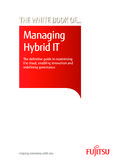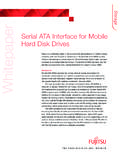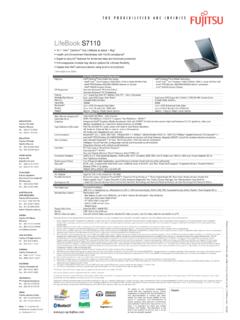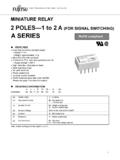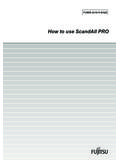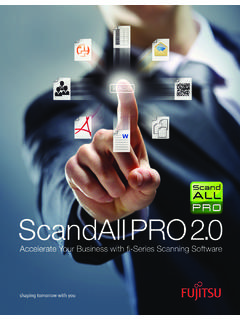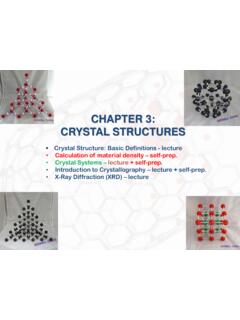Transcription of Fundamentals of Liquid Crystal Displays – How They Work ...
1 Fundamentals of Liquid Crystal Displays How They Work and What They DoWHITE PAPER Fundamentals of Liquid Crystal Displays How They Work and What They Do Page 2 Fujitsu Microelectronics America, Inc. Liquid Crystal display technology has enjoyed significant advances in just a few short years. The quality of LCD panels has improved dramatically while at the same time costs have gradually come down. LCDs are now found in products as small as mobile phones and as large as 42-inch flat panel screens. This white paper identifies the major types of LCDs, describes the technology in detail, shows how it works, and identifies major LCD applications as well as leading global suppliers. The paper also defines and describes Organic Light Emitting Diodes (OLEDs), which represent a powerful new trend. Finally, the paper includes a description of how LCDs are integrated into two important products from Fujitsu: Graphics Display Controllers for vehicles and mobile media processors for consumer electronic devices.
2 Fundamentals of Liquid Crystal Displays .. 3 Backlit and Reflective LCDs .. 3 Types of LCDs Passive 4 Active Matrix or TFT (Thin Film Transistor) LCDs .. 8 Future Trends .. 8 OLED (Organic Light Emitting Diode) 8 Applications of OLED Displays .. 9 The LCD Interface in Fujitsu s Graphic Display Controllers .. 10 The LCD Interface in Fujitsu s Mobile Multimedia Processors .. 11 Jasmine Display Controller by Fujitsu .. 11 LCD Display Suppliers Information .. 12 OLED Display Suppliers 13 Fundamentals of Liquid Crystal Displays How They Work and What They Do Page 3 Fujitsu Microelectronics America, Fundamentals of Liquid Crystal Displays The term Liquid Crystal is used to describe a substance in a state between Liquid and solid but which exhibits the properties of both. Molecules in Liquid crystals tend to arrange themselves until they all point in the same specific direction.
3 This arrangement of molecules enables the medium to flow as a Liquid . Depending on the temperature and particular nature of a substance, Liquid crystals can exist in one of several distinct phases. Liquid crystals in a nematic phase, in which there is no spatial ordering of the molecules, for example, are used in LCD technology. One important feature of Liquid crystals is the fact that an electrical current affects them. A particular sort of nematic Liquid Crystal , called twisted nematics (TN), is naturally twisted. Applying an electric current to these Liquid crystals will untwist them to varying degrees, depending on the current's voltage. LCDs use these Liquid crystals because they react predictably to electric current in such a way as to control the passage of working of a simple LCD is shown in Figure 1. It has a mirror ( A ) in back, which makes it reflective. There is a piece of glass ( B ) with a polarizing film on the bottom side, and a common electrode plane ( C ) made of indium-tin oxide on top.
4 A common electrode plane covers the entire area of the LCD. Above that is the layer of Liquid Crystal substance ( D ). Next comes another piece of glass ( E ) with an electrode in the shape of the rectangle on the bottom and, on top, another polarizing film ( F ), at a right angle to the first one. The electrode is hooked up to a power source like a battery. When there is no current, light entering through the front of the LCD will simply hit the mirror and bounce right back out. But when the battery supplies current to the electrodes, the Liquid crystals between the common-plane electrode and the electrode shaped like a rectangle untwist and block the light in that region from passing through. That makes the LCD show the rectangle as a black area. Back Lit and Reflective LCDs Liquid Crystal materials emit no light of their own. Small and inexpensive LCDs are often reflective, which means if they are to display anything, they must reflect the light from external light sources.
5 The numbers in an LCD watch appear where the small electrodes charge the Liquid crystals and make the crystals untwist so that the light is not transmitting through the polarized LCD Displays are lit with built-in fluorescent tubes above, beside and sometimes behind the LCD. A white diffusion panel behind the LCD redirects and scatters the light evenly to ensure a uniform display. On its way through Liquid Crystal layers, filters and electrode layers, more than half of this light is lost such as in LCD Displays on personal the reflective mode, available light is used to illuminate the display. This is achieved by combining a reflector with the rear polarizer. It works best in an outdoor or well-lighted office environment. Transmissive LCDs have a transparent rear polarizer and do not reflect ambient light. They require a backlight to be visible. They work best in low-light conditions, with the backlight on continuously.
6 Transflective LCDs are a mixture of the reflective and transmissive types, with the rear polarizer having partial reflectivity. They are combined with backlight for use in all types of lighting conditions. The backlight can be left off where there is sufficient light, conserving power. In darker environments, the backlight can provide a bright LCDs will not wash out when operated in direct sunlight. Another feature of the viewing mode is whether the LCD is a positive or negative image. The standard image is positive, which means a light background with a dark character or dot. This works best in reflective or transflective mode. A negative image is usually combined with a transmissive mode. Figure 1 Fundamentals of Liquid Crystal Displays How They Work and What They Do Page 4 Fujitsu Microelectronics America, Inc. This provides a dark background with a light character. A strong backlight must be used to provide good illumination.
7 In most graphic applications, the transmissive negative mode is inverted. This combination provides a light background with dark characters, which offers the user better voltage and sharpness of the response are important parameters to characterize the quality of LCDs. The threshold voltage, Vth, is the amount of voltage across the pixel that is necessary to produce any response whatsoever. Sharpness' of the response can be calculated by finding the difference in voltage necessary to go from a 10% to a 90% brightness (usually written as V90 V10).Another characteristic of Displays that must be dealt with is the switching times of the pixels. These are commonly written as T on and T off , and they correspond to the amount of time between application/removal of the voltage and a 90% brightness/darkness response. Usually T off , is slightly larger, because after voltage is removed, the Liquid Crystal relaxes back into its off state.
8 No force is being applied, unlike when it is being turned on. Switching times can be changed by controlling the amount of orientational viscosity in the Crystal , which is the amount of resistance when being forced to change direction. The contrast of a Liquid Crystal display is an important issue as well. One way to measure it is to find the difference in brightness between an on and off pixel, divided by the larger of the two values. A more useful value is the contrast ratio , which is simply the larger brightness divided by the smaller brightness. LCD designers want this ratio to be as large as possible in order to obtain "blacker blacks"' and "whiter whites." Typical LCDs have contrast ratios between 10 and 40. Unfortunately, the contrast will depend on the angle the display is viewed from since the effects of the Liquid Crystal are calibrated to work best on light passing through the display perpendicularly.
9 When viewed from an angle, we are not seeing the light coming out perpendicularly from the Liquid Crystal , so it is common to see a breakdown in the contrast. In some cases it is even possible to see a negative image of the display. Types of LCDs Passive Matrix These LCDs use a simple grid to supply the charge to particular pixels on the display. Passive Matrix LCDs start with two glass layers called the substrates. One substrate is given rows and the other is given the columns, made from a transparent conductive material. The Liquid Crystal material is sandwiched between the two glass substrates, and the polarizing film is added to the outer side of each display. To turn on a pixel, the integrated circuit sends a charge down the correct column of one substrate and a ground activated on the correct row of the other. The row and column intersect at a designated pixel, and that delivers the voltage to untwist the Liquid crystals at that pixel.
10 As the current required to brighten a pixel increases (for higher brightness Displays ) and, as the display gets larger, this process becomes more difficult since higher currents have to flow down the control lines. Also, the controlling current must be present whenever the pixel is required to light up. As a result, passive matrix Displays tend to be used mainly in applications where inexpensive, simple Displays are required. Direct addressing is a technique mostly used in Passive Matrix Displays in which there is a direct connection to every element in the display, which provides direct control over the pixels. But direct addressing is not good in some instances because in large Displays there can be thousands or even millions of pixels that require separate connections. The method used in the vast majority of large modern Displays is multiplexing . In this method, all the pixels across each row are connected together on the plate on one side of the Liquid Crystal film, and all the pixels in each column are connected on the opposite side.


